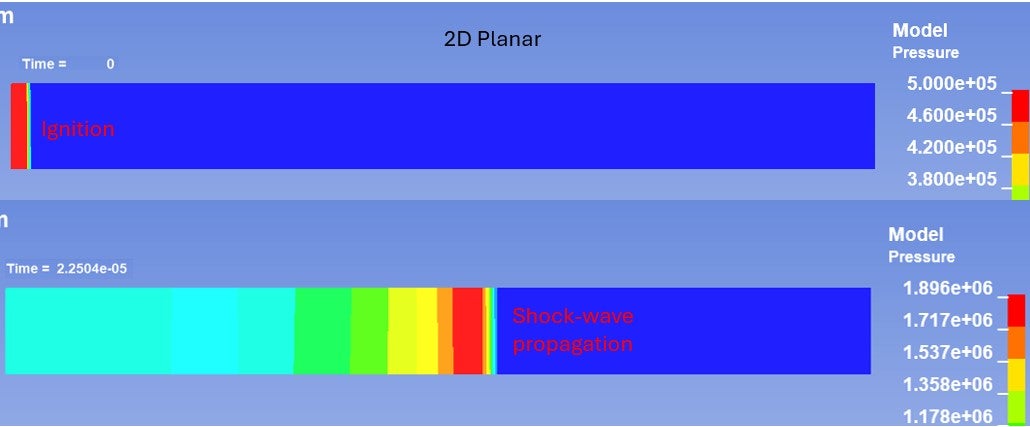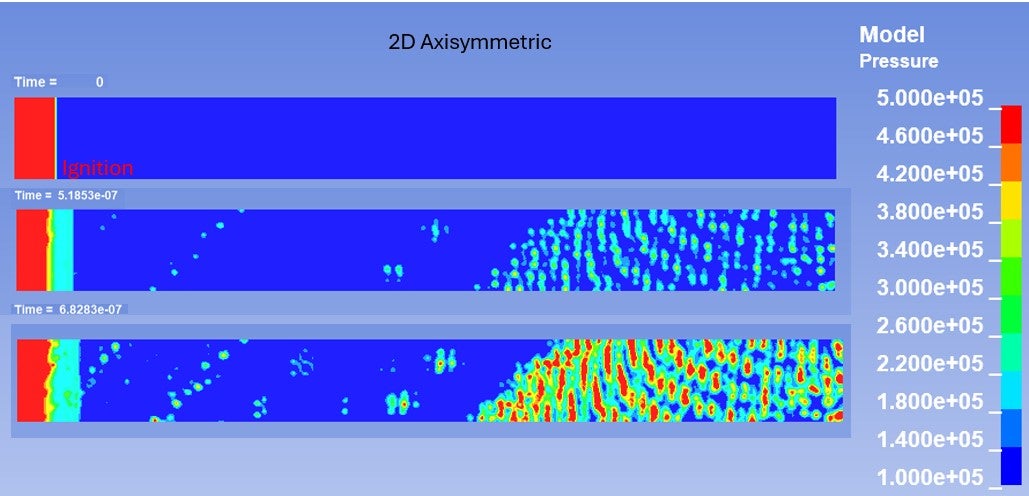TAGGED: 2d-axisymmetric, CESE, cfd-convergence, chemistry, detonation, hydrogen-combustion, ls-dyna
-
-
May 27, 2024 at 5:50 pm
s.machadomartins
SubscriberHello, I'm trying to set up a simple 2D axisymmetric simulation using the compressible CESE Chemistry (inviscid). I defined an H2-O2 reaction mechanism with 8 reactions and gave the thermodynamic input file.
Background:
The simulation domain is a rectangle with solid walls and an ignition zone with high pressure and temperature. When I use a 2D planar simulation (igeom=2), a shock wave develops and propagates in the H2-O2 mixture. The temperature, pressure and speed of the shock wave closely match the theoretical CJ values for hydrogen detonation, so I assume the simulation is correct (see the image below).Problem:
However, when I switch to the 2D Axissymetric simulation the simulation doesn't converge and weird/non-physical values show up in the results. Instead of a uniform propagation of the shock wave, I get random spots with non-sense values (even away from the ignition point), as shown below. The only difference to the 2D planar simulation is that I define the *CESE_BOUNDARY_AXISYMMETRIC in the y-axis and change the *CESE_CONTROL_SOLVER card to perform a 2D axisymetric simulation (igeom=101).
The error message is:
*** Error 150209 (CHEM+209)
Chemistry EOS nonlinear temperature solver failed to converge.
Error code = 50 Last iterate temperature = -0.21165E+04I tried to simplify the problem by reducing the reaction mechanism and removing the ignition but the problem persists. Additionally, I reduced the mesh size and the time step and still doesn't converge. However, if I run the CESE axisymmetric simulation without the chemistry cards the results are okay.
Has anyone faced similar problems or has any idea on how to approach these issues??
I need to set up the axisymmetric case since my next step is to run a simulation of a cylinder with bigger dimensions. -
July 10, 2024 at 7:45 pm
Ushnish Basu
Ansys EmployeeWe have fixed several bugs recently regarding the chemically-reacting flow solver, especially as affecting the 2D-axisymmetric case.
Please try out a recent Dev version or an updated R15 version. You will have to contact your Ansys account representative to get access to these version.
-
October 16, 2024 at 1:54 pm
DENG
SubscriberHello,I have recently been trying to use compressible CESE to compute the H2-O2 reaction. However, the shock wave's temperature, pressure, and velocity I obtained differ significantly from the theoretical CJ values for hydrogen explosion. Would you be able to share the K file and the thermodynamic input files? Do the final shock wave's temperature, pressure, and velocity depend on the thermodynamic input files? My email address is 1779414982@qq.com. I look forward to your reply! -
October 16, 2024 at 3:26 pm
DENG
SubscriberHello, may I ask if your model was downloaded from a website? Could you share it, please? -
October 17, 2024 at 1:05 pm
s.machadomartins
SubscriberHello, most of the thermodynamic files I tried were able to capture the CJ values correctly, as long as there are no errors in the input file. The SDToolbox developed by Caltech has a good collection of H2-O2 reactions models and thermodynamic inputs for detonation simulations (https://shepherd.caltech.edu/EDL/PublicResources/sdt/). Are you using a long enough domain to let the detonation build-up? There's always an acceleration phase after ignition for which the temperature and pressure are below the CJ values. Also, the ignition is important, a weak ignition may cause a deflagration instead of a detonation, which will differ from the CJ values. Usually, an ignition with a high pressure (1.5-2 MPa) followed by a high-temperature zone (2000-3000K) is enough.
I couldn't find any models using chemistry in LS-DYNA examples, only CESE models without chemistry. But I'll send you my Shock Tube problem by email. Note that this model is 2D-axisymmetric and it doesn't converge for versions below the R15 development version, where they fixed some robustness bugs.
-
October 30, 2024 at 2:41 pm
Atish Gawale
SubscriberHello,
Were you able to use MPP Double precision solver?. I get non physical results with MPP_D.
Regards,
Atish
-
November 1, 2024 at 4:42 pm
s.machadomartins
SubscriberHi Atish,
Yes, I'm using mpp_d_R15 version for linux and mpirun. I had some problems with R14 version, but R15 works fine.
Regards,
Simão
-
- The topic ‘CESE Chemistry solver fails in 2D Axisymmetric case’ is closed to new replies.



-
4678
-
1565
-
1386
-
1242
-
1021

© 2025 Copyright ANSYS, Inc. All rights reserved.









